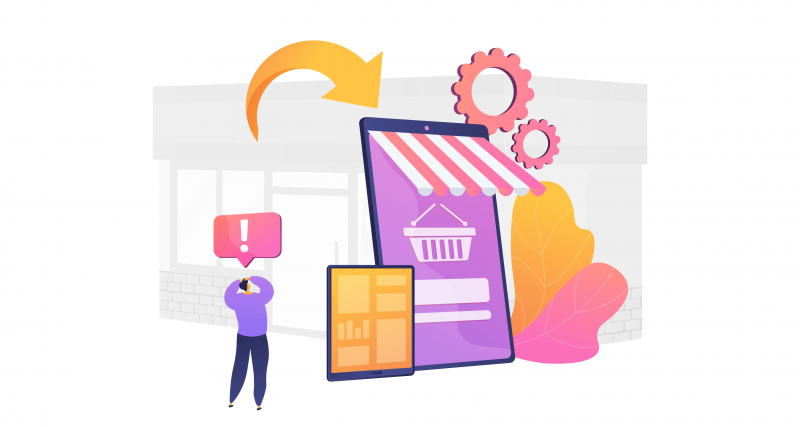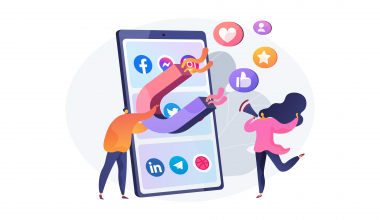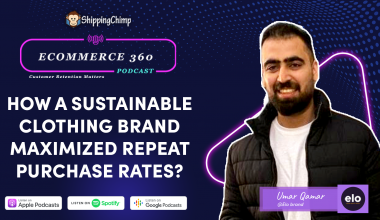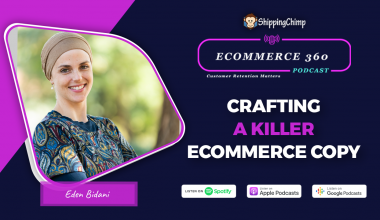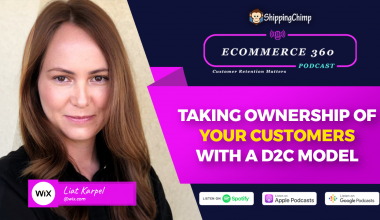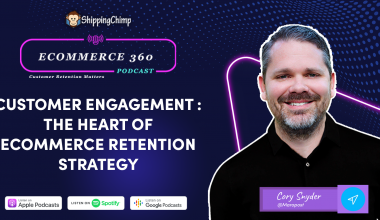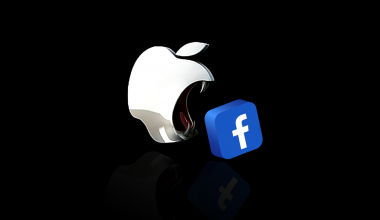We had an opportunity to converse with an extremely talented mompreneur Keri Jamieson founder of KeriKit limited. This blog is about her journey towards success, she takes us through the hardships that she overcame with sheer will and pure passion.
You can learn more about the following:
1. From infancy stages to now: Growth story
2. What are the primary sources of acquisition?
3. What does their tech stack look like?
4. Metrics that matter the most
5. Shipping notification and other retention strategies to boost repeat purchase rate
6. Future of Kerikit and advice to fledgling e-commerce business owners
Revathi: Hey eCommerce 360 watchers. Today we have Keri Jamieson founder of KeriKit limited which is a gorgeous practical multifunctional leather handbags and accessories store. Hey Keri, welcome to our show!
Keri: Thank you so much for having me. I’m very excited to be here.
Revathi: We are excited to have you here. So Keri before we talk about the growth story let us a bit into your backstory. How did you conceive this idea and what was that eureka moment?
Keri: Kerikit is now six years old I can’t believe we’ve made it to six years I’m very proud of myself that we’ve got this far and as with most brands I think they tend to come out of frustration or something that we see that is missing in the community or in the world and for me, I was pregnant with my first child I had always been in buying and fashion and liked nice things and I went into a well-known retailer to look for a bag that I could use once I had a baby and I was just really disappointed because the bags were really ugly overpriced and terrible leather not thought through obviously not designed by a fellow mom to be or somebody that understood fashion and handbags and I was just yeah I was really disappointed. I walked out with a disgusting rip stock gray messenger bag just functional there was nothing sexy about it at all and I was just really deflated as a woman I just thought is this the best that we can do like I’m having a baby I’m not changing my entire identity here this is difficult enough having a baby and leaving behind my career and things like that and there are all these things going on your head and on top of that I can’t even carry a nice handbag come on now.
I walked out and just bought this horrible bag and and then I got pregnant with twins and I lit back into the same store and thought right things must have changed it’s 20 months later and just stood there against this wall thinking gosh this is so depressing like I cannot believe this is all you’re giving me as choice and I think as you said that was my eureka moment, I was like hang on a second I have been a buyer of accessories for seven years at TK Maxx, I have designed accessories and handbags for 20 years for most of the high street that you see today and have seen in the past and for europe and for china and for america just maybe I was put on this planet to bring women like me beautiful bags that are not just a changing bag we are a kit bag and they are beautiful products that you can use for all of motherhood motherhood isn’t just those first 12 months you know where they’re pushing around you’re a mom forever and I just feel empowered and sexy when you go out in the morning with something that you know is going to help save you time and keep you organized and that was why KeriKit was born.
Revathi: That’s a brilliantly fascinating story! So from your story, there’s one more thing I understand, you had no prior experience in running any store of course you had an interest in fashion and knew what women were looking for, what you wanted but you didn’t have any prior experience in running a fashion store. Coming up with a website and then following up with metrics and having a payment gateway and all those so from the time you started your store until now what has been the kind of trials and tribulations that you went through in getting the store to the revenue level?
Keri: I’d say I didn’t invest correctly at the very beginning like you said I had no idea what I was doing I spoke to some people we designed a website we were using Woocommerce at the time it was very clunky I had a lot of development fees going on within it so I was always asking the developer to come in and fix things I couldn’t run it myself so I had no ability to bring that overhead down and it was just this kind of beast really that was always taking up my time and my money and it wasn’t really achieving what I wanted it to achieve. I used that for probably a couple of years and I must have gone through two or three websites in the first couple of years and if I’d just gone to the right person at the beginning and got expert advice at the beginning and I think that’s my takeaway to anybody that’s listening is if you don’t know what you’re doing go get help. I spent so many years not getting help and thinking I could do it myself and getting the cheapest person in or this or that and when I look back now if I just did it properly at the start I don’t think I would have spent half as much money as I did getting it wrong four times.
About two years ago I think it was I made the decision to move to Shopify now it comes with his expenses because obviously, you’ve got to pay for the apps that you download onto it you’ve got to pay for your subscription you’ve got to use their gateway but what you get is this easy site that somebody who is perhaps not into coding their own websites like me can have it on their phone and really run the whole of their website if they need to off their phone but equally be empowered to make changes that they need to when they need to so I can change pretty much anything on the site myself and that’s just my time so you can then balance as a new business whether you want to spend your time and how valuable your time is versus giving it to somebody else to do so I have a developer that goes in and does other bits for me but for me. t I think as a new business it just provides you with such a cost-effective way of getting your products online.
Revathi: Absolutely Shopify is built for e-commerce businesses that are looking to take off. Let’s talk a little bit about marketing so how did you make your first sale? Was it in your mom’s group? I’m sure you would have had some sort of a group of moms because you were a mom like twice so you would have had a huge network of moms so was it through that or did you build some sort of community on Facebook?
Keri: Gosh! The first sale I remember very well I went to an event in London in Olympia it was a baby show and I had absolutely no idea whether I was going to sell one 100 I had it was just like well what if we sell out and what if we do this then why don’t we do that so I hired a tail lift truck I was boxing up these boxes going well I’ve put four in I may as well put in eight well I may as well put in 12. I might as well put in four boxes because I had no idea what was going to happen and drove five hours to London. I had these massive great big display units that I’ve been given for free and at the time I was like god this is that this is exactly what I was looking for beautiful backlit glass big display cabinets with big kitchen units underneath I’m so lucky to get them for free and then I realized why they were free because some other idiot had thought they were the perfect display cabinets until you had to get them to an event and set them up and like reel them in on these great big six-foot trolleys and it was a nightmare.
I think we sold that first weekend six units and I came back bearing in mind I was totally unknown we launched there and my bags were Italian leather they were incredibly expensive I suppose for a brand new brand that had no marketing behind it whatsoever but we still sold bags and I was like okay this is at least something these people know me from nowhere.
I’ve just parted with 400 pounds at a baby show but my biggest learning I would say is I have now realized that I know how to design a bag I can design a bag manufacturer bag importer bag with no problem but selling a bag, the marketing side I had absolutely no experience on and I failed miserably really at the start because I honestly thought if I design it then people will find me and I will be able to sell the bags it will be that easy like all I need is a website and then they will come. That wasn’t the case for me at all and I guess one of the other challenges I made for myself was I didn’t want to be a changing bag I’m not a changing bag so for keywords seo and all the things that you need as a business to be found on some platforms like google you need to have your keywords sorted so it’s been a real battle for me to wonder if I should just be a changing bag and then not have women that buy my bags right now want to buy them because they buy them because they’re not a changing bag but be found on google or stick with the the uses of social media to tell my story but then not be found on google so it’s a little bit of a challenge for me to know which is the the right way to go and for six years I’ve really battled with not giving myself the name changing bag at all and literally today we are going through all of the website and we are making the title a very versatile title so we are making the title a sentence that explains to the versatility of the product so we can be found but we don’t alienate people who want to buy it as a work bag or a travel bag or things like that so yeah it’s a very it’s always a bit of a challenge.
Revathi: Very interesting! Going on two years or three years down the line you can figure out what your acquisition channels are all, what is your acquisition channel and how did you double down on your acquisition channel?
Keri: Eventually we tried a lot of different things, Facebook advertising was brilliant for a while google advertising is good if you are not on page one yourself because your website’s not hasn’t got the authority then paying to get on page one is the second option that you have we did Pinterest as well and it’s a kind of a case of trial and error to see where your audience are. We also created a kickball group on Facebook it’s around 710 members and they really are an amazing group of women who are very passionate about the brand and they do enable other people to buy so if you go into the rabbit hole then as they call it you end up making purchases because everyone’s so helpful in there and they’re just showing you how great the bags work for all of them.
In Linkedin, we created a reward scheme so you can get into different levels and tiers based on how many purchases that you make and that’s been great for keeping our customers and the loyalty that we get. We do have the odd discount and things like that but we’re not really into discounting so much we find that the rewards worked really really well.
I think we have like a 46 return rate so you know we have again I think we have less than a three percent return on products as well so we know we make an amazing product and we know when you get it you’re going to love it and generally we know that you’re going to come back and buy more.
Revathi: Let’s talk a bit about the influences, network of people trying to recommend your bags. Do you have any influences like celebrity influencers who are out there trying to promote your bags and how has that worked for your brand?
Keri: Yeah, influence is a really tricky one! So we have an affiliate program and we do have certain people on there like Amy Willetton who was miss world she’s one of our affiliates Talitha Minnis she’s a celebrity she has but then we have people who just buy the bag because they don’t want to have to do that bit so we have Pippa Middleton she has one of our bags and we’ve got one picture of her out and about with it Stacey Solomon, Rochelle Humes but those people have kind of come and bought the bag so that they need the under an agent’s fee.
I find that the influencer market is very challenging and sometimes I feel that the big influences really expect an awful lot in return for you know you do a deal with them you give them a bag they say that they’ll promote it for you and then they do nothing whereas the micro-influencers with only like between two and ten thousand followers often have really great engagement they’re much happier to work with you the rule the rule that we generally have is we don’t work with anybody that’s not had a carry kit bag that they bought themselves, so we don’t work with anybody that just comes to us knocking on our doors saying oh we love your brand can we work with you you’re not genuine and I don’t really want the feeling to be that people are promoting my products because they’ve been told to they’re making money off the back of it because it’s not authentic whereas if they are already a KeriKit customer and they’re already promoting me then we’ll approach them and do them on an invite-only basis.
Revathi: It’s very interesting, very authentic! Let’s talk a little bit about metrics, when did you start tracking your metrics? What kind of metrics do you track and what are your not-star metrics?
Keri: I wasn’t very good at tracking metrics. I’m not gonna lie I’m a designer and we are more creative than we are numbers but I realized about three years into the business that if I wasn’t checking my metrics I really had no idea what I was doing so I check basically Shopify is very good at giving you your analytics so that’s a very quick place to go and just get like a a bird’s eye view top line what’s your best seller what are you selling out of we use our inventory system to know what we’re selling how much we’ve sold what margins we’ve made on everything which is helpful and in top of that we have google analytics so we have a system set up that will let us know where our customers have come from what they’ve looked for what the keywords are that they’re looking for to find us and then my accountant my xero accounting which I used that was the one I never used to look at but now I’m literally in there the whole time because if you’re not keeping an eye on your overheads they will overtake you and you suddenly you know we’ve grown year on year.
I think we’ve doubled the business year on year since conception but I’m quite happy to confess that we had an amazing year and a very bad year last year with covid and whilst we doubled our business and our turnover was amazing and I looked like it was super successful my overheads had increased without me noticing and we hadn’t actually made as much so I think sometimes it’s a bit of a fool’s errand where you think the turnover means I’m successful and actually it’s profits what’s your gross profit that’s where you’re that’s where your success really lies and to understand that you really need to be in those numbers the whole time.
Revathi: Absolutely! Let’s quickly talk about retention. You mentioned a three percent repeat purchase rate on overall products. How do you engage your audience for repeat purchases, what kind of strategies do you use and how often do customers come back to get the bags?
Keri: It’s a 46 percent return rate on customers, how many more of them come and buy ones they’ve bought and we have a three percent return rate on refunds like people who want to send things back. So generally it’s just bringing out new products and so I will do IGTV I will do youtube videos and I actually in lockdown had a studio made we had a container converted into an office space so I now have a little showroom where I can literally grab I was to do it today but it’s like 45 degrees in there so I couldn’t go in there and and I can talk through the products and I can educate people on the leathers that we use and it’s really that journey and I think that the reason people buy from me and come back is my quality is amazing my price points are very very reasonable for what you get you are getting the best best quality leather it’s the product that’s been well thought through by a fellow mom who’s also got 25 years designing handbags so generally people tend to come back because they get one and it’s better than they were expecting because I’m not in any stores and so my overheads can can remain quite low that way but also it’s a shame because they can’t see the products so this way is we can either do zoom appointments if you’re not local or you can come up to the showroom now we had a visitor yesterday who came to the showroom and it’s funny she picked a completely different bag than she thought she was going to pick once she saw it so it’s a challenge it’s always a challenge to get the quality across on a website that’s always been a challenge for me but we have found solutions that you can do to sort of make it work but generally bringing out new products standing there and saying guys what do you think about this this is new for spring summer 22 and then they all scream at me and go crazy and one thing that’s really nice. I have sort of supported them and letting that happen and what they get is a limited edition piece that no one else will have that you will never find on my website and so that’s kind of a really nice way of making my community feel part of my decision making is I think part of the magic of my brand.
Revathi: Let’s talk about the future. Kerikit seems to be in hyper-growth mode, what kind of future are you envisioning? Are you envisioning a future with a lot more designs for your packs or are you going to expand the product line? Are you going to expand the geographies? What kind of vision are you looking at?
Keri: I think at the moment if we expand anything it will be more the territories that we’re in and perhaps doing bricks and mortar I’ve always shied away from it really because we did we were in Nordstrom, we were in America, we had a fulfillment center in America and I was in this like big growth we went to the Shanghai fair we had the Chinese and we’re really keen to get Kerikit and I was talking to agencies and then I suddenly thought Keri it’s you like it’s just you and a couple of assistants helping you at that time like how are you going to do this, how are you going to do this massive growth and the cost to do the growth, the cost to break into China is hundreds of thousands of pounds so I kind of backtracked a little bit from that and went very insular and got right. We’ll just be online only that way, the margin is only for me. I can keep the prices lower, use the best quality leather, and just basically create a product however I want it to be. I don’t have to think about whether it fits the margins of other people
Lockdown was very lucky because I got to know my community and because I had already created this private group once lockdown happened. I was already in front of the house, I was already communicating with my community, and lots of my competitors I think floundered because suddenly the stores didn’t take their orders and they have a clue how they were supposed to run things other than posting a picture and spending buyers and Harrods so it really was a win for me at that point. I think now I’ve grown a little more. I’m at that point now where I’m considering the right people might be worth collaborating with to allow every kid to be in certain stores so that you can go and see them before you make a purchase.
You don’t need to be in such a hurry to bring out so many things because I want to design that I think it can over face the customer and they’re looking like oh my god I want the bag in all five colors what am I going to do whereas three colors the cost to do the photography the cost for the photoshoots everything would be less and I would be able to have more longevity with the product I’m so excited to design something new every season. It’s always very exciting because there’s always a new product that comes to the market that’s amazing.
Revathi: So as a piece of parting advice what would be yours for upcoming momtrepreneurs or entrepreneurs or e-commerce business owners?
Keri: As I said at the beginning if you’re not sure get advice get support go and get a mentor to find somebody that has done it before that can guide you through because as long as much as people say it’s okay to make mistakes, they’re learnings, don’t make them if you don’t have to at the end of the day the learnings all the mistakes are going to cost your business money so if you can avoid those and somebody else has been there and done it then listen, to them listen to the podcast, listen to the experts, there are books there are so many self-help things that you can do yourself to educate yourself but equally if you don’t know it get somebody else in and you know if you’re you’re if you’re a luxury brand graphics is really important don’t just try and do them all yourself but equally there is so much you can do on certain things like Canva you know Canva makes photoshop archaic because you can get virtually everything you want out of certain things like that.
I have full-time virtual assistants so they are totally part of my business this was before lockdown and now it seems like it’s normal to work remotely with people you don’t need to be in an office but when I started working with my virtual assistants that were before that really happened and you know I’m supporting a mom of two a single mom of two who’s really struggling right now who’s in permanent lockdown in Jamaica and is financially doing okay because of me. So there’s part of it, it’s like you know it’s a shame you’re not employing people in the UK but equally, I’m supporting somebody else that really needs to be supported right now who is a mother just like me and so it’s also a very cost-effective way of starting out until you want to have people on your own payroll. Having freelancers means you can switch it on, switch it off, use them as much as you want to so again your overheads are in your control.
Revathi: Absolutely! Thank you so much Keri for the wonderful interview and it was a pleasure having you on.
Keri: Thank you so much for having me. I’ve really enjoyed it.
.
